Author:Dafon Kerbstone Machine FROM:Stone Machine Manufacturer TIME:2024-09-19
Brief introduction to stone fabrication industry
Stone fabrication is a critical part of the construction and design industries, transforming raw stone materials into refined products such as countertops, tiles, sculptures, and monuments. The process involves cutting, shaping, and polishing stone to achieve the desired aesthetic and functional qualities. Traditionally, stone fabrication relied on manual labor and basic cutting tools, often time-consuming and limited in precision. However, with the advancement of technology, modern tools like diamond wire saws have revolutionized the industry, offering unparalleled accuracy, speed, and versatility in cutting various types of stone. This cutting-edge tool has become essential for fabricators aiming to enhance efficiency and product quality.
Overview of diamond wire saw in stone fabrication
In stone fabrication, precision and efficiency are key to achieving high-quality results. traditional methods, such as saw blades and waterjets, have long been used in stone cutting, but they come with limitations in speed, accuracy, and material waste. The diamond wire saw has emerged as a game-changing tool, revolutionizing stone fabrication with its superior cutting capabilities. Combining advanced technology with durable diamond-coated wire, this tool offers unmatched precision, versatility, and efficiency, making it the ultimate solution for modern stone-cutting needs.
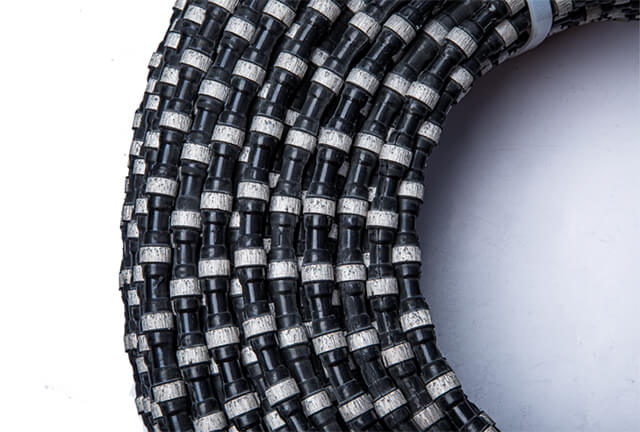
Explanation of a diamond wire saw and how it works
A diamond wire saw is a specialized cutting tool that uses a thin wire embedded with industrial-grade diamond beads to slice through stone. The wire, usually made of high-strength steel, is looped around a stone block or slab, and the saw operates by moving the wire at high speeds to grind through the stone. As the diamond beads on the wire make contact with the material, they wear it away with incredible precision. The wire is cooled with water or another coolant during the process to prevent overheating and extend the lifespan of the tool. Diamond wire saws come in various forms, including stationary machines for large-scale block cutting and portable versions for on-site work, making them versatile enough for a wide range of applications in stone fabrication.
Types of diamond wire saws
CNC-Integrated Diamond Wire Saws
CNC-integrated diamond wire saws combine the cutting power of a diamond wire with the precision of computer numerical control (CNC) technology.
The benefits of CNC-integrated diamond wire saws include:
Precision and Accuracy: The CNC system allows for meticulous control over the cutting process, ensuring each cut is perfectly aligned with the design specifications.
Complex Cuts: These machines can handle intricate patterns and complex geometries, making them perfect for detailed stonework such as sculptures, ornate architectural elements, and custom countertops.
Automation: CNC systems reduce manual labor, as the operator can program the machine to run autonomously, leading to increased production efficiency and reduced operator fatigue.
Consistency: Once programmed, the machine can repeat the same cutting process with consistent precision, ensuring uniformity across multiple pieces.
CNC-integrated diamond wire saws are essential tools for modern stone fabrication businesses that need to balance high-volume production with the demand for custom, detailed work.
Multi-Wire Diamond Saws
Multi-wire diamond saws are highly advanced machines designed to maximize cutting efficiency in large-scale stone fabrication operations.
Key Features of Multi-Wire Diamond Saws:
High Throughput:
Capable of cutting multiple slabs from a single stone block at once.
Ideal for mass production, particularly for materials like granite and marble.
Precision Cutting:
Despite the high output, the wires ensure precision and uniformity in slab thickness.
Perfect for creating standardized products in bulk.
Material Efficiency:
Reduces material waste due to its thin cutting lines, compared to traditional saws.
Helps fabricators make the most of each stone block, minimizing resource loss.
Cost-Effectiveness:
High initial investment but offers long-term savings through increased output and reduced labor costs.
Suitable for companies looking to scale up production without compromising quality.
Adaptability:
Can be adjusted to cut different slab thicknesses depending on the project’s requirements.
Widely used in the production of countertops, floor tiles, and other standardized stone products.
Multi-wire diamond saws are a game-changer in the stone industry, providing the perfect combination of speed, accuracy, and efficiency.
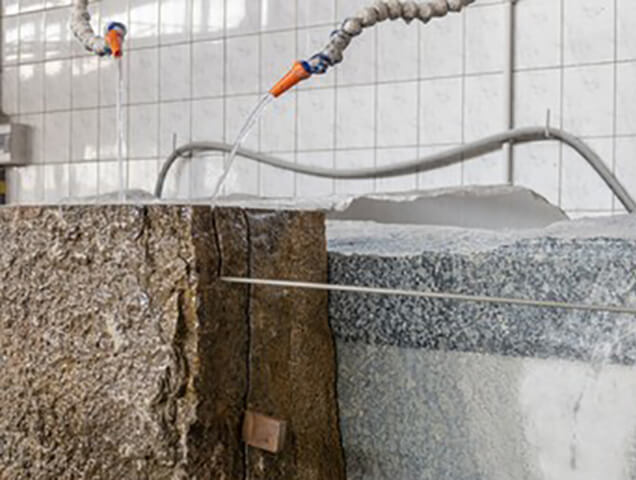
The diamond wire saw has transformed the stone fabrication industry, becoming the ultimate tool for several compelling reasons:
Precision Cutting:
Diamond wire saws excel in producing highly accurate cuts, making them ideal for complex designs, intricate patterns, and custom stonework. The fine-cutting action allows for detailed work on marble, granite, and other natural stones with minimal error, ensuring superior results in architectural, artistic, and commercial stone projects.
Versatility:
Unlike traditional cutting tools, diamond wire saws can be used across a wide range of stone materials, from soft stones like limestone to hard stones like granite and quartz. Whether the project involves slabs, blocks, or sculptures, the diamond wire saw provides flexibility to adapt to various stone types and shapes with ease.
Efficiency:
The cutting speed of diamond wire saws is significantly faster than conventional methods, leading to improved production rates. The technology ensures more precise cuts, reduces the need for secondary processing, and minimizes material waste, which ultimately saves time and resources.
Smooth and Clean Cuts:
One of the standout features of diamond wire saws is their ability to produce smooth, clean cuts with minimal chipping or cracking. This results in high-quality finishes that require little to no post-cut polishing or finishing, greatly enhancing the efficiency of the stone fabrication process.
Cost-Effectiveness:
While the initial investment in diamond wire saw technology may be higher than traditional saws, it offers significant cost savings in the long run. The durability of the diamond wire, combined with reduced material waste and labor costs, provides a strong return on investment, making it a practical choice for fabricators aiming for long-term profitability.
Reduced Material Loss:
Traditional saw blades can result in substantial material loss due to the thickness of the blade. Diamond wire saws, however, have much thinner cutting lines, which reduces waste and maximizes the use of the stone block. This is particularly important when working with expensive materials like granite and marble.
Environmentally Friendly:
By reducing waste and enhancing the efficiency of the cutting process, diamond wire saws contribute to more sustainable stone fabrication. The reduced need for water in cooling (compared to some other cutting methods) and lower energy consumption make it a greener option for stone manufacturers.
In summary, the diamond wire saw’s precision, versatility, efficiency, and long-term cost-effectiveness make it the ultimate tool for modern stone fabrication. Its ability to handle a wide range of materials with minimal waste and superior finish quality ensures that fabricators can meet both the creative and practical demands of today’s industry.

Diamond Wire Saw vs. Traditional Saw Blades
When comparing diamond wire saws to traditional saw blades, several key differences highlight why the diamond wire saw has become a preferred choice in modern stone fabrication. Here's a detailed comparison:
1. Cutting Precision
Diamond Wire Saw:
Offers superior precision and control, making it ideal for intricate and detailed cuts.
The thin diamond-coated wire enables fine and accurate cuts with minimal deviations.
Traditional Saw Blades:
Precision can be limited due to the thickness of the blade and its tendency to cause vibrations.
May require additional finishing work to achieve the same level of detail.
2. Cutting Speed
Diamond Wire Saw:
Provides faster cutting speeds, especially beneficial for large-scale or high-volume production.
Efficiently slices through stone blocks, reducing overall processing time.
Traditional Saw Blades:
Typically slower, particularly when cutting through hard or thick materials.
Cutting speed can be impacted by blade wear and the need for frequent replacements.
3. Material Waste
Diamond Wire Saw:
Minimizes material waste due to its thin cutting line, which conserves valuable stone.
Efficiently utilizes stone blocks, resulting in higher yield and reduced loss.
Traditional Saw Blades:
Thicker blades result in more significant material loss, as the width of the cut creates more waste.
Less efficient in maximizing the use of each stone block.
4. Surface Finish
Diamond Wire Saw:
Produces smoother and cleaner cuts with minimal chipping or cracking.
Reduces the need for extensive post-cut polishing or finishing.
Traditional Saw Blades:
Cuts may have rougher edges and more chipping, requiring additional finishing processes.
More likely to produce uneven or irregular cuts.
5. Versatility
Diamond Wire Saw:
Highly versatile and can handle a wide range of stone types, including very hard materials like granite and quartz.
Suitable for various cutting shapes and sizes, including complex and customized designs.
Traditional Saw Blades:
Generally less versatile, with limitations based on blade type and material hardness.
Better suited for straight cuts rather than intricate designs.
6. Cost and Maintenance
Diamond Wire Saw:
Higher initial investment due to the advanced technology and machinery.
Long-term cost savings through reduced material waste, fewer blade replacements, and increased efficiency.
Traditional Saw Blades:
Lower initial cost for blades and saw equipment.
Ongoing costs for blade replacements, maintenance, and potential downtime due to blade wear.
7. Environmental Impact
Diamond Wire Saw:
More environmentally friendly due to reduced material waste and energy efficiency.
Requires less water for cooling compared to some other cutting methods.
Traditional Saw Blades:
May generate more waste and require additional resources for cooling and maintenance.
Environmental impact can be higher due to greater material loss and energy consumption.
In summary, while traditional saw blades have been a staple in stone fabrication, the diamond wire saw offers significant advantages in terms of precision, efficiency, and material conservation. Its ability to deliver smooth, clean cuts with minimal waste makes it a superior choice for modern stone cutting needs
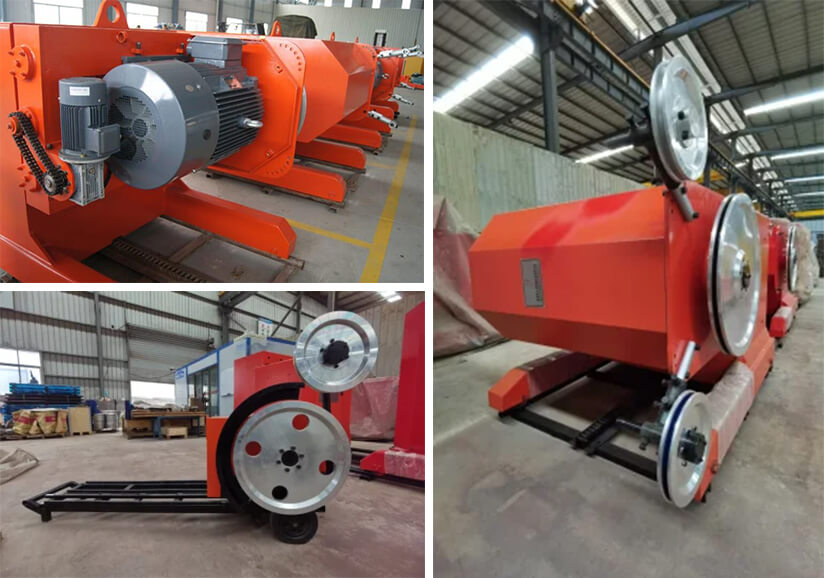
Diamond wire saws have become indispensable tools in the stone fabrication industry due to their versatility and efficiency. Here are some key applications where diamond wire saws excel:
1. Slab and Block Cutting
Description: Diamond wire saws are commonly used to cut large stone blocks into slabs or smaller blocks, providing precise thickness and size.
Benefits: Ensures uniformity and high-quality finishes for each slab, with minimal waste of material. Ideal for producing standard-sized slabs for countertops, tiles, and other architectural elements.
2. Monument and Tombstone Fabrication
Description: Used to carve and shape monuments, tombstones, and memorials from large stone blocks.
Benefits: Allows for intricate designs and personalized engravings with high precision. The clean and smooth cuts facilitate detailed work and reduce the need for additional finishing.
3. Custom Stone Design
Description: Ideal for creating custom stone pieces, including decorative elements, sculptures, and artistic installations.
Benefits: Provides the flexibility to cut complex shapes and patterns, accommodating unique and artistic requirements. The precision of the diamond wire saw enables fine details and high-quality craftsmanship.
4. Architectural Elements
Description: Utilized in the production of architectural stone elements such as facades, columns, and flooring.
Benefits: Offers accurate cutting for precise dimensions and design specifications. Ensures a high level of finish quality, which is crucial for architectural and design applications.
5. Quarrying Operations
Description: Used in quarrying to extract large stone blocks from natural deposits with minimal waste.
Benefits: Enhances efficiency in the extraction process by cutting through the stone with precision, reducing the need for secondary processing, and improving the overall yield from each quarry block.
In summary, diamond wire saws play a crucial role in the stone fabrication industry by offering exceptional precision, versatility, and efficiency. Their ability to handle a wide range of applications—from large-scale slab cutting to intricate custom designs—makes them an essential tool for both standard and specialized stonework.
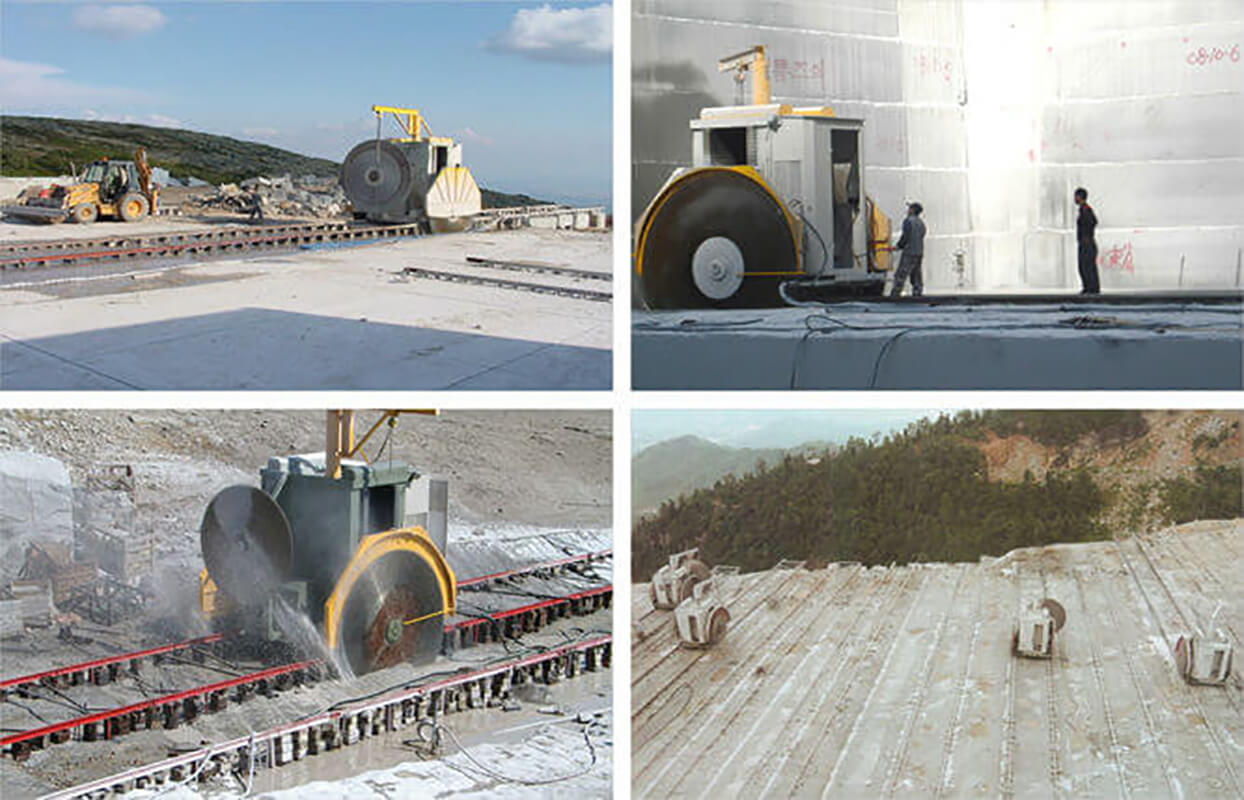
Best Practices for Using a Diamond Wire Saw
Using a diamond wire saw involves several steps to ensure efficient, accurate, and safe cutting of stone materials. Here’s a comprehensive guide on how to use a diamond wire saw effectively:
1. Preparation
Safety Gear:
Wear appropriate safety gear including goggles, gloves, hearing protection, and a dust mask to protect against debris and dust.
Machine Setup
Ensure the diamond wire saw is properly installed and set up according to the manufacturer’s instructions. Check that all components, including the diamond wire, pulleys, and motor, are securely in place.
Stone Preparation:
Position the stone block or slab securely on the work surface or saw bed. Ensure it is properly aligned and supported to prevent movement during cutting.
2. Adjusting the Machine
Wire Tension:
Adjust the tension of the diamond wire according to the manufacturer’s specifications. Proper tension ensures smooth cutting and prolongs the life of the wire.
Cutting Parameters:
Set the cutting speed and feed rate based on the type of stone and the desired cut. Different stones may require different settings for optimal results.
3. Cutting Process
Start the Machine:
Power on the diamond wire saw and allow it to reach the desired speed before starting the cut. Gradually feed the stone into the cutting area.
Monitor the Cutting:
Keep an eye on the cutting process to ensure the wire remains on track and the cut is proceeding as planned. Watch for any signs of issues such as excessive vibration or irregular cutting.
Cooling System:
If the machine uses a cooling system (such as water), ensure it is functioning correctly to prevent overheating and to remove debris from the cutting area.
4. Post-Cutting Procedures
Stop the Machine:
Once the cut is complete, turn off the diamond wire saw and allow the machine to come to a complete stop before removing the stone.
Remove the Stone:
Carefully remove the cut stone from the work area. Inspect the cut for accuracy and quality, and make any necessary adjustments or refinements.
Maintenance:
After use, clean the machine and inspect the diamond wire for wear or damage. Replace or sharpen the wire as needed to maintain optimal performance.
5. Safety and Maintenance
Regular Inspection:
Conduct regular maintenance checks on the diamond wire saw to ensure all components are functioning correctly. Look for signs of wear or damage and address them promptly.
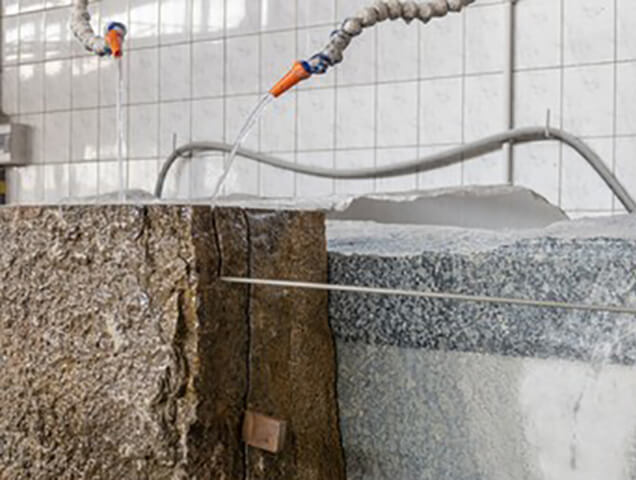
A diamond wire saw is a specialized cutting tool used in mining operations to extract valuable minerals from rock formations. It operates on a simple yet effective principle: a continuous loop of steel cable, embedded with tiny diamond abrasives, is passed over the rock to be cut.
Here's a breakdown of the process:
Wire Preparation: The diamond wire saw is fitted with a steel cable that has been impregnated with diamond grit. The diamond grit, typically composed of synthetic diamonds, is bonded to the cable using either an electroplating or sintering process.
Tensioning: The cable is then tensioned to a specific level, ensuring optimal cutting performance.
Cutting Process: The tensioned wire is passed over the rock to be cut. As the wire moves, the diamond abrasives on the wire grind away at the rock, creating a narrow groove.
Water Cooling: To prevent overheating and ensure efficient cutting, a steady stream of water is directed onto the cutting area. The water helps to cool the wire and remove debris from the cutting zone.
Kerf Formation: As the wire continues to move, the groove it creates deepens until it eventually cuts through the rock, forming a kerf.
Extraction: Once the kerf has been completed, the rock can be extracted from the mine.
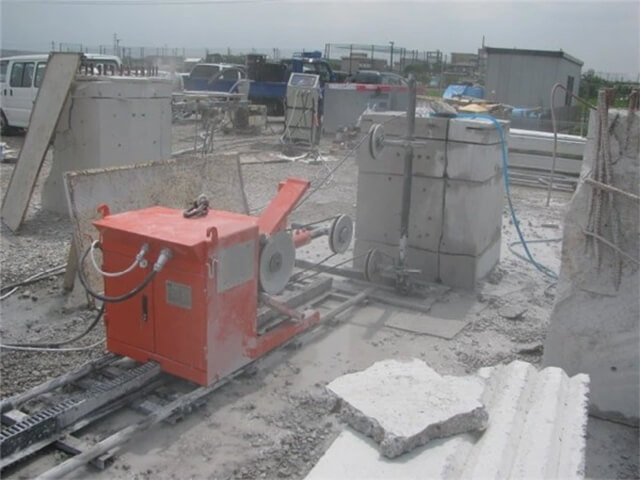
Key Advantages of Diamond Wire Saws in Mining:
Precision: Diamond wire saws can make extremely precise cuts, minimizing waste and maximizing the recovery of valuable minerals.
Efficiency: They are highly efficient tools, capable of cutting through hard rock formations at relatively high speeds.
Versatility: Diamond wire saws can be used to cut a wide variety of rock types, including those with varying hardness and composition.
Safety: Compared to traditional methods like blasting, diamond wire saws are generally safer, as they do not involve the use of explosives.